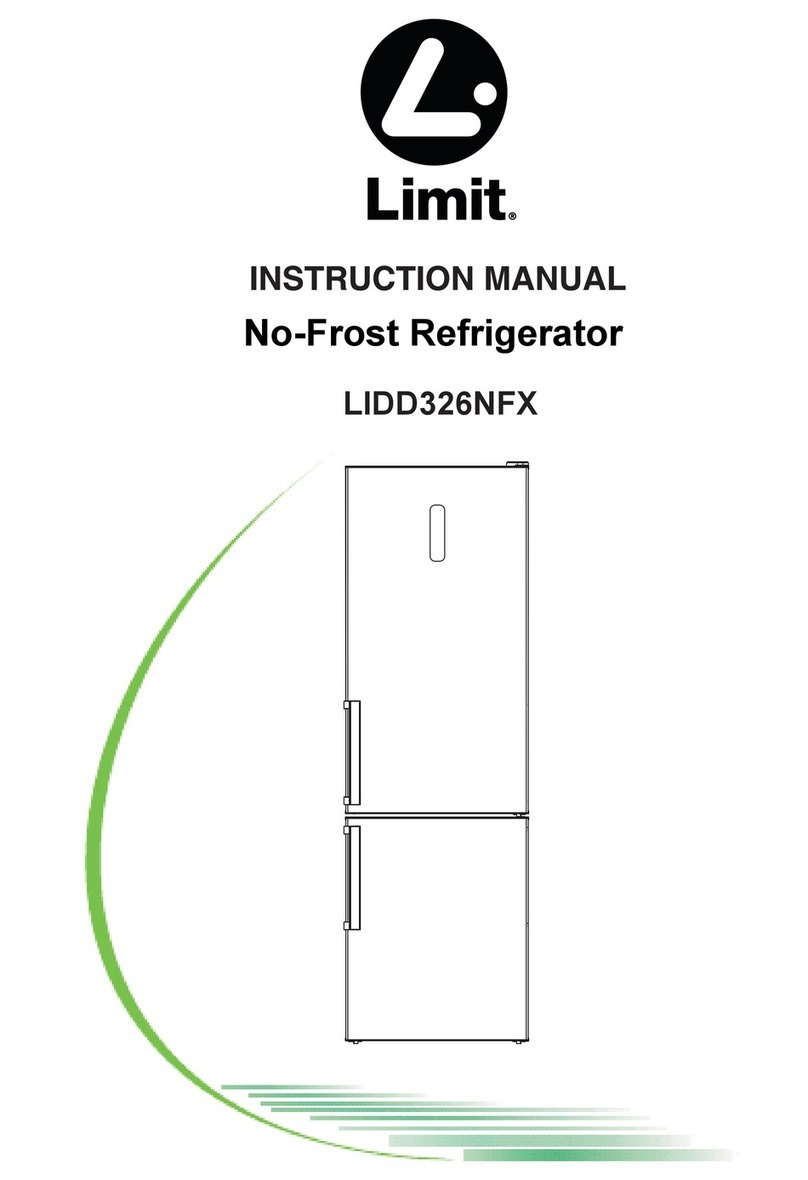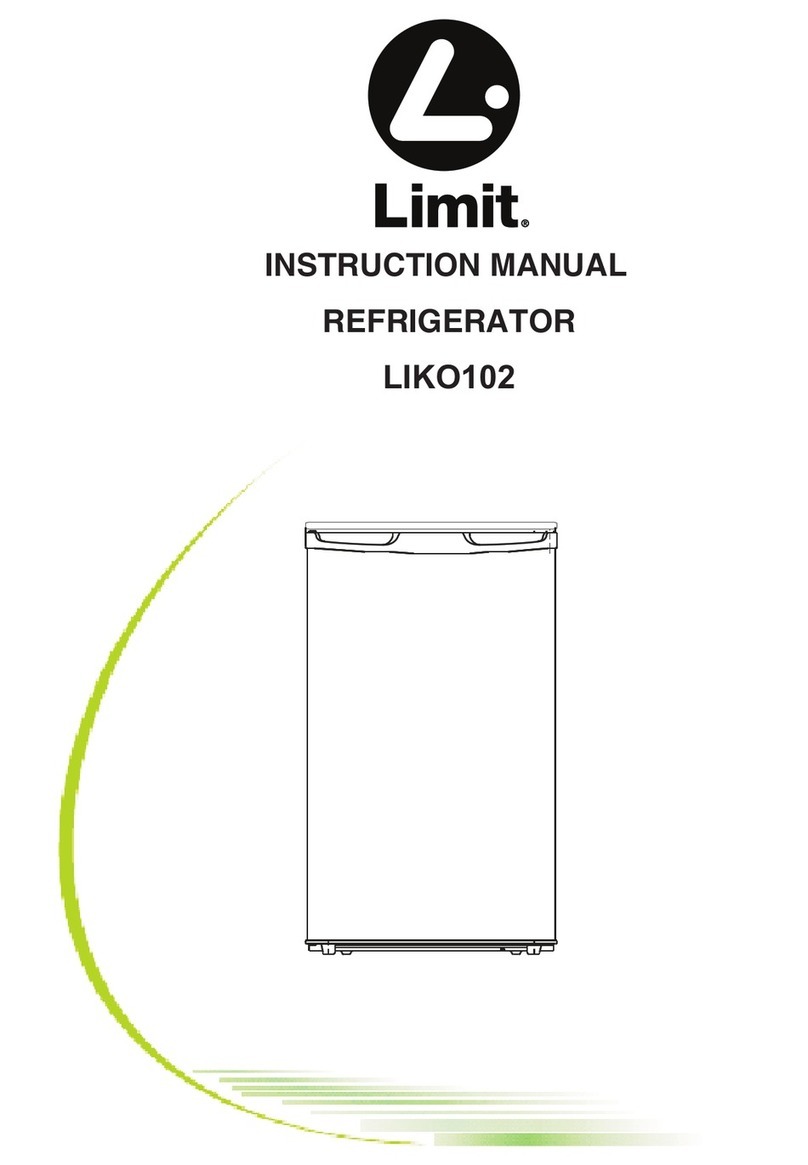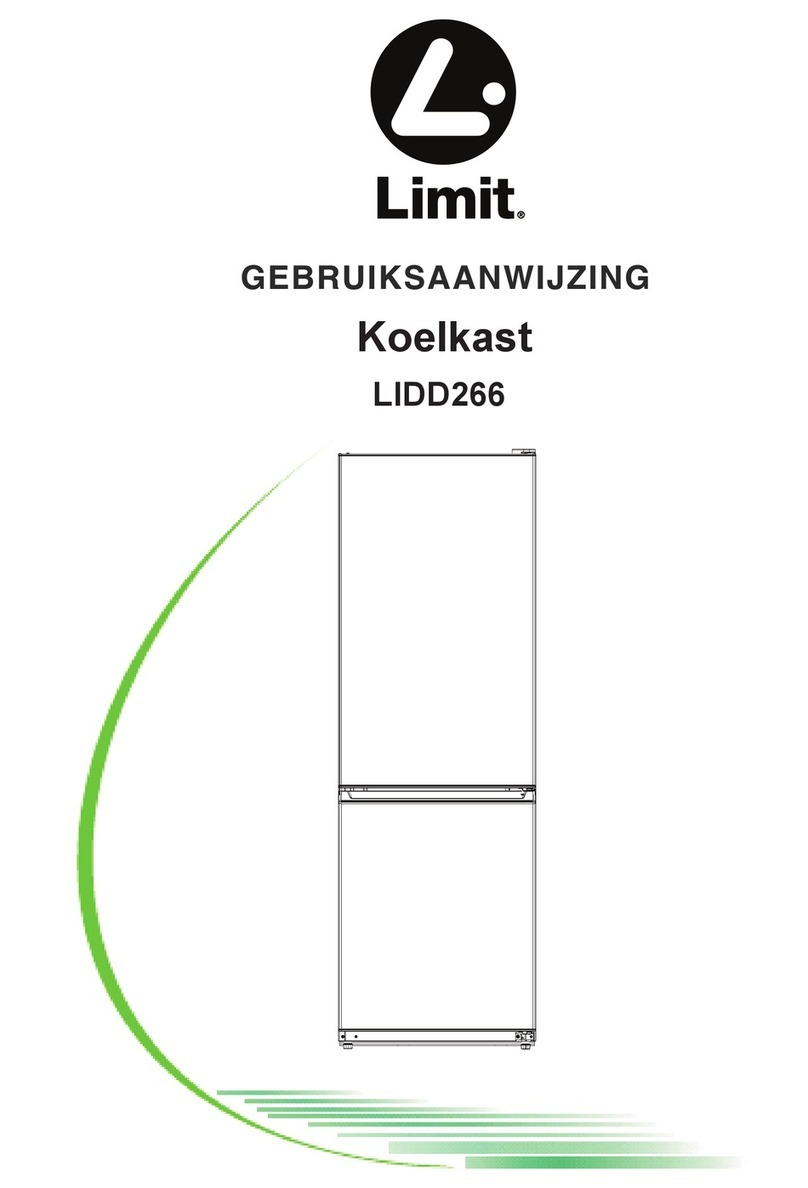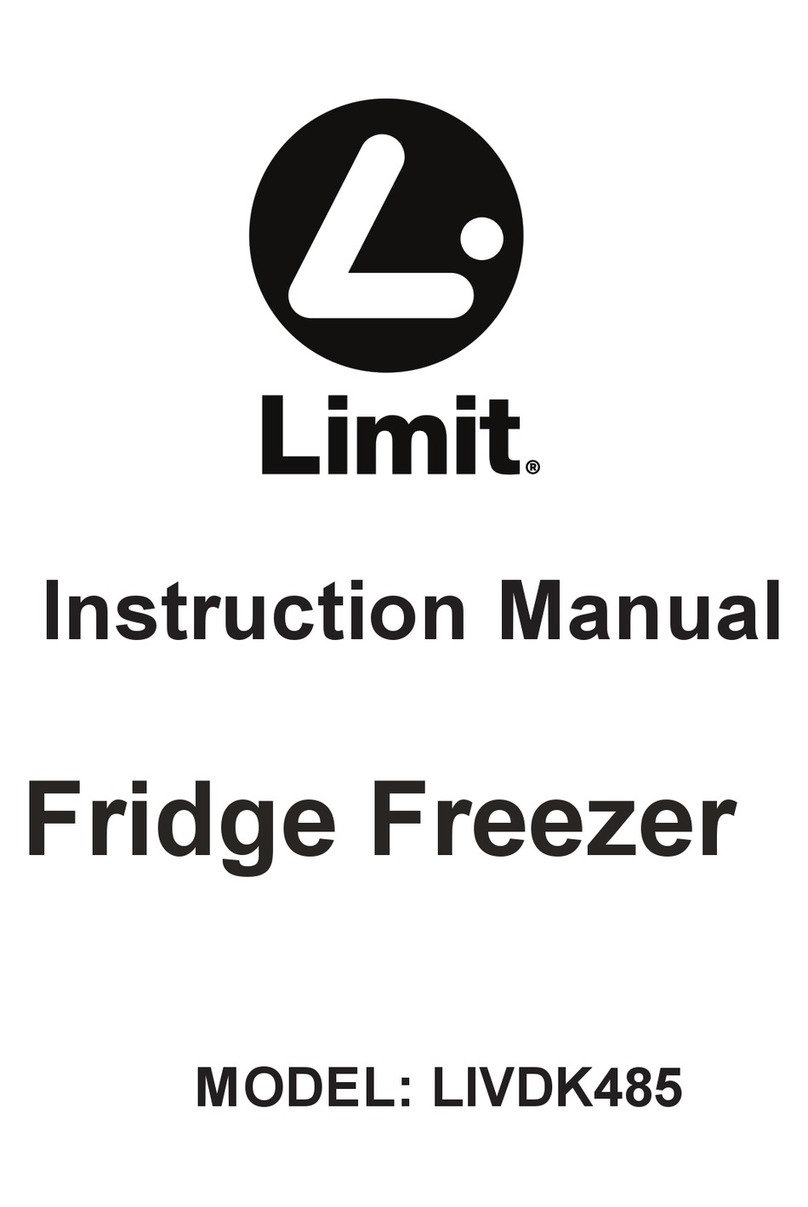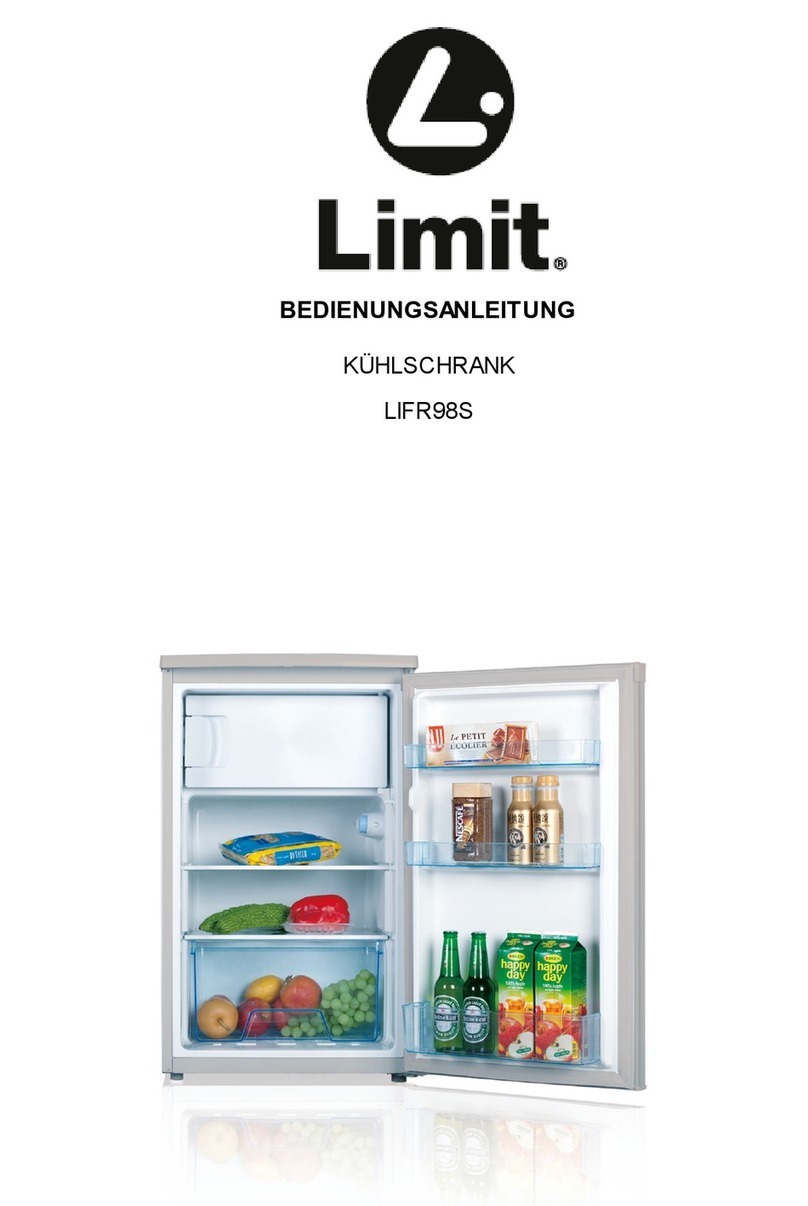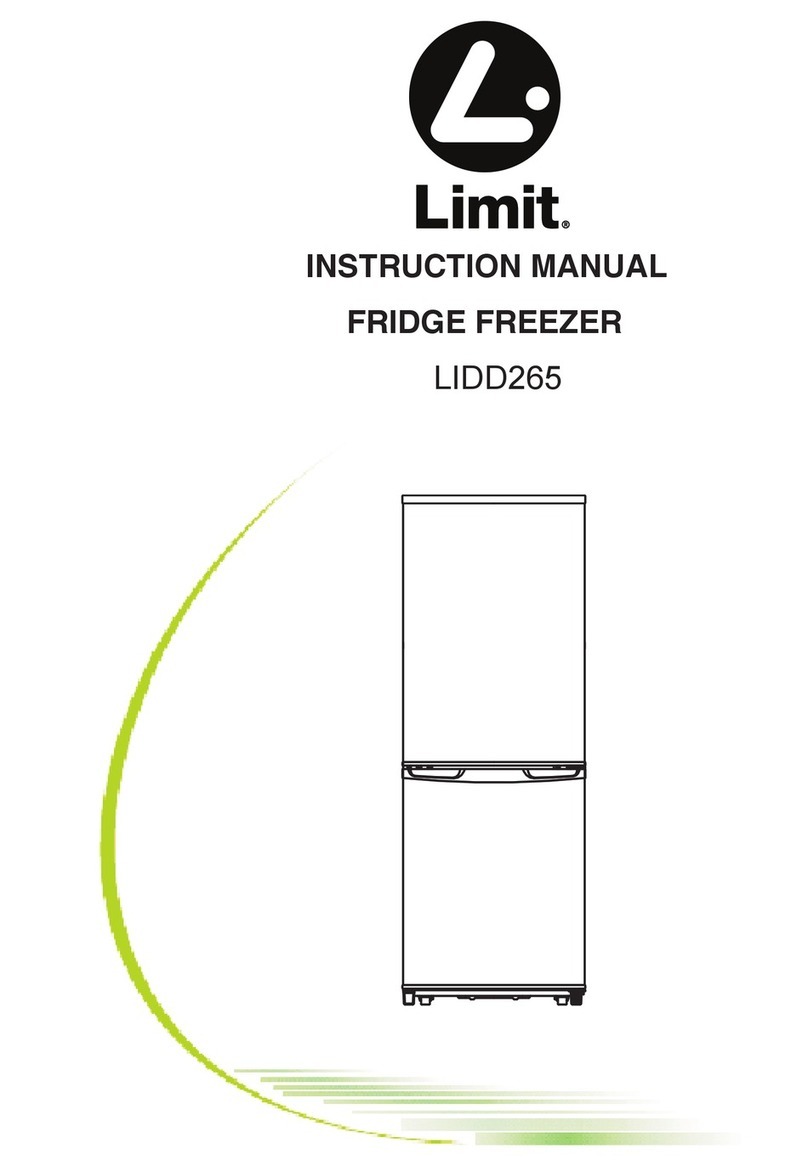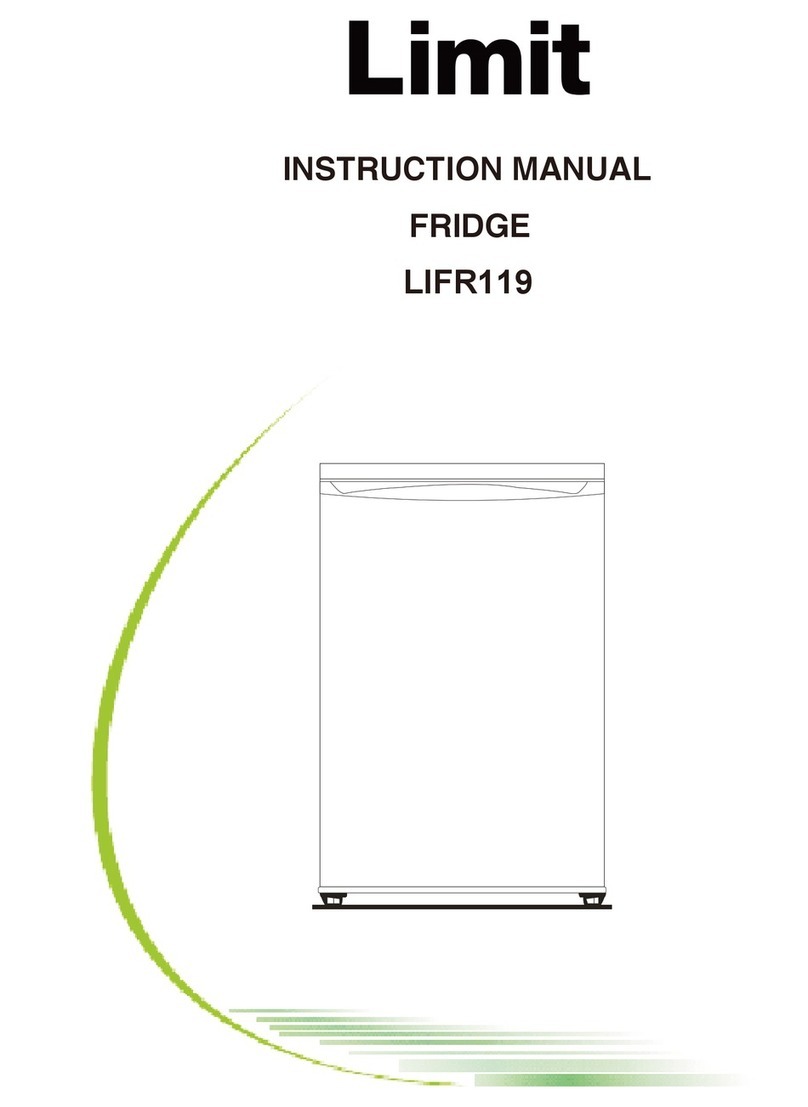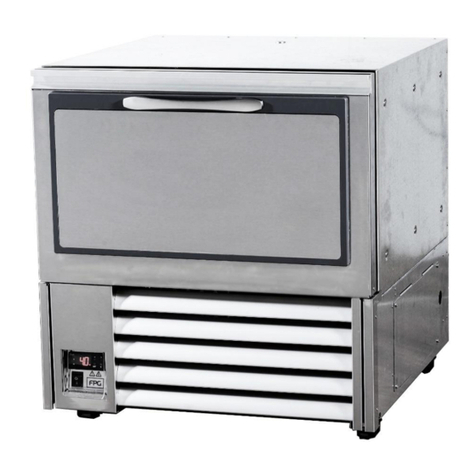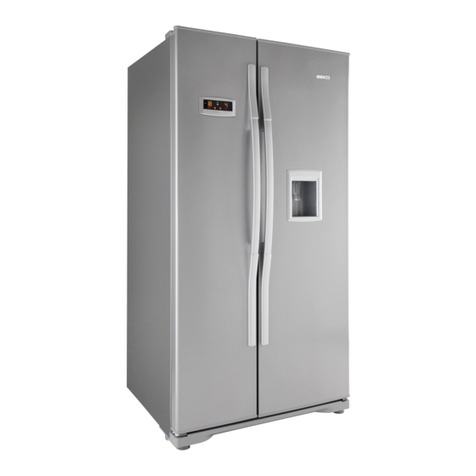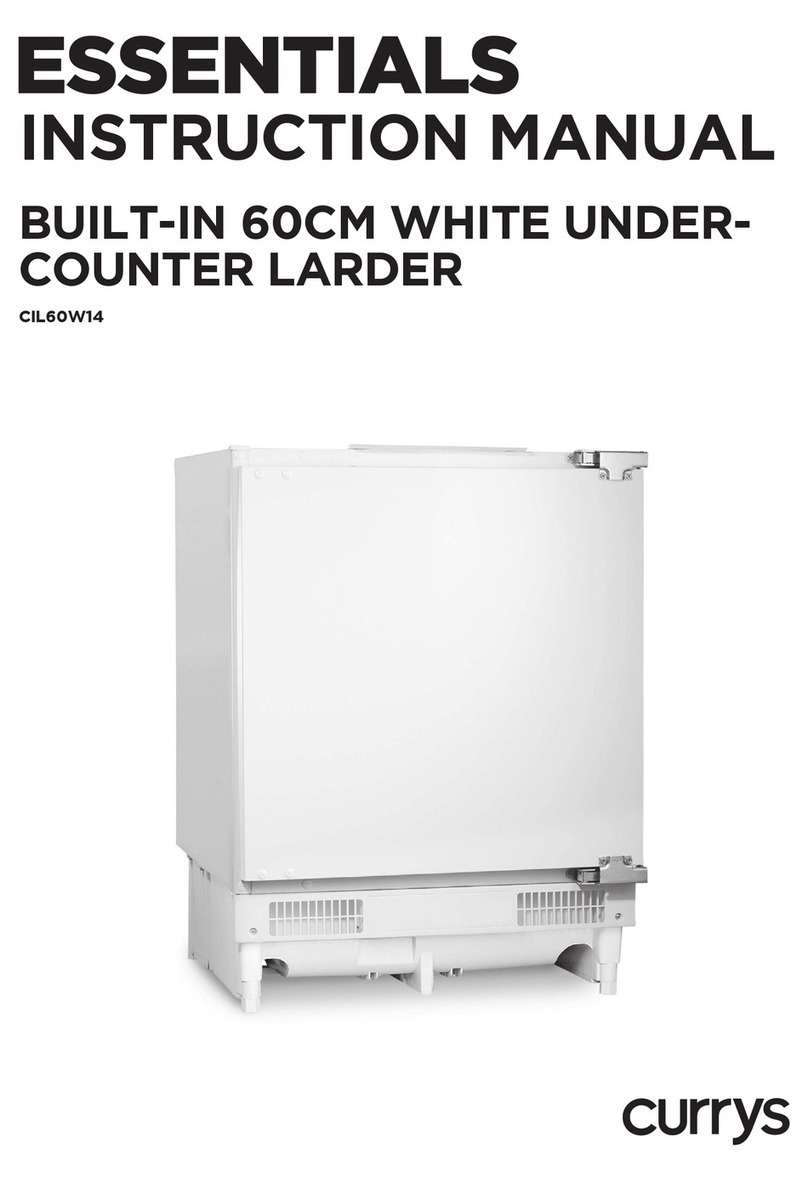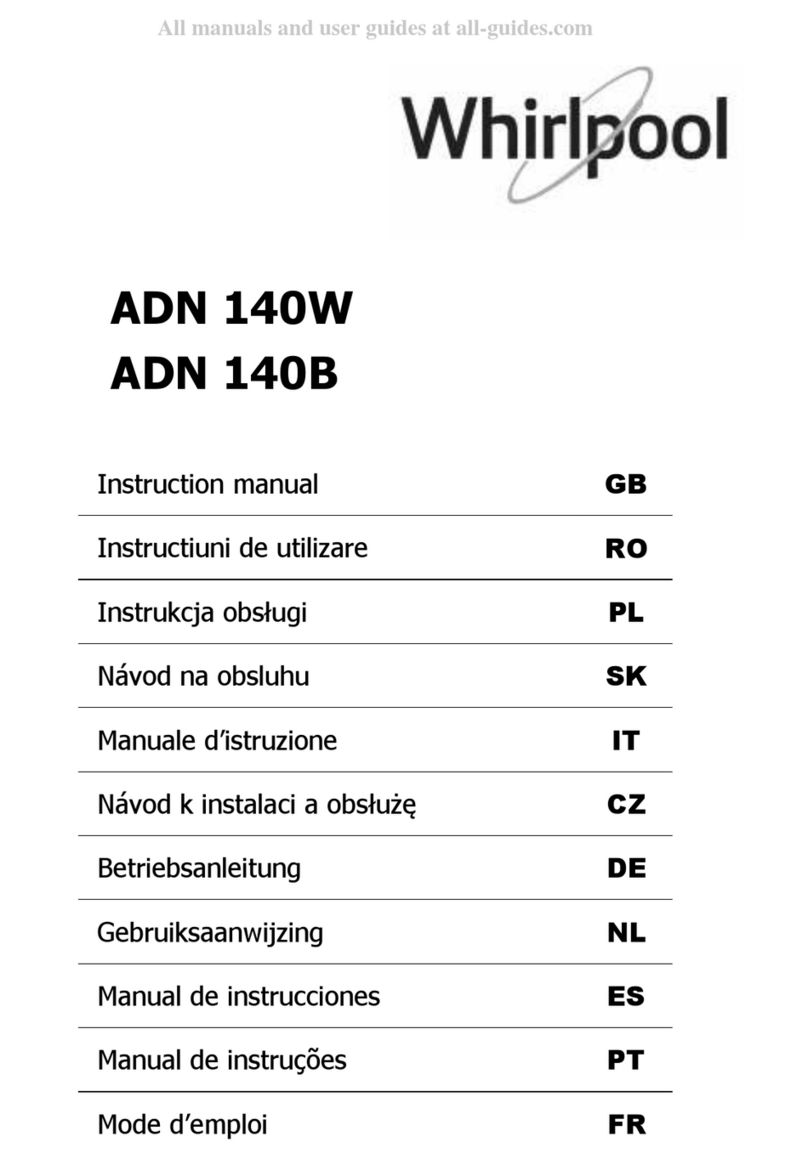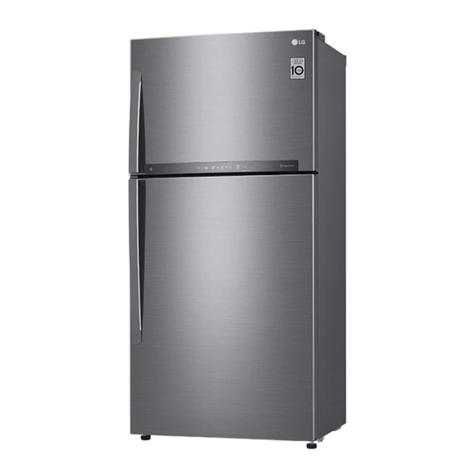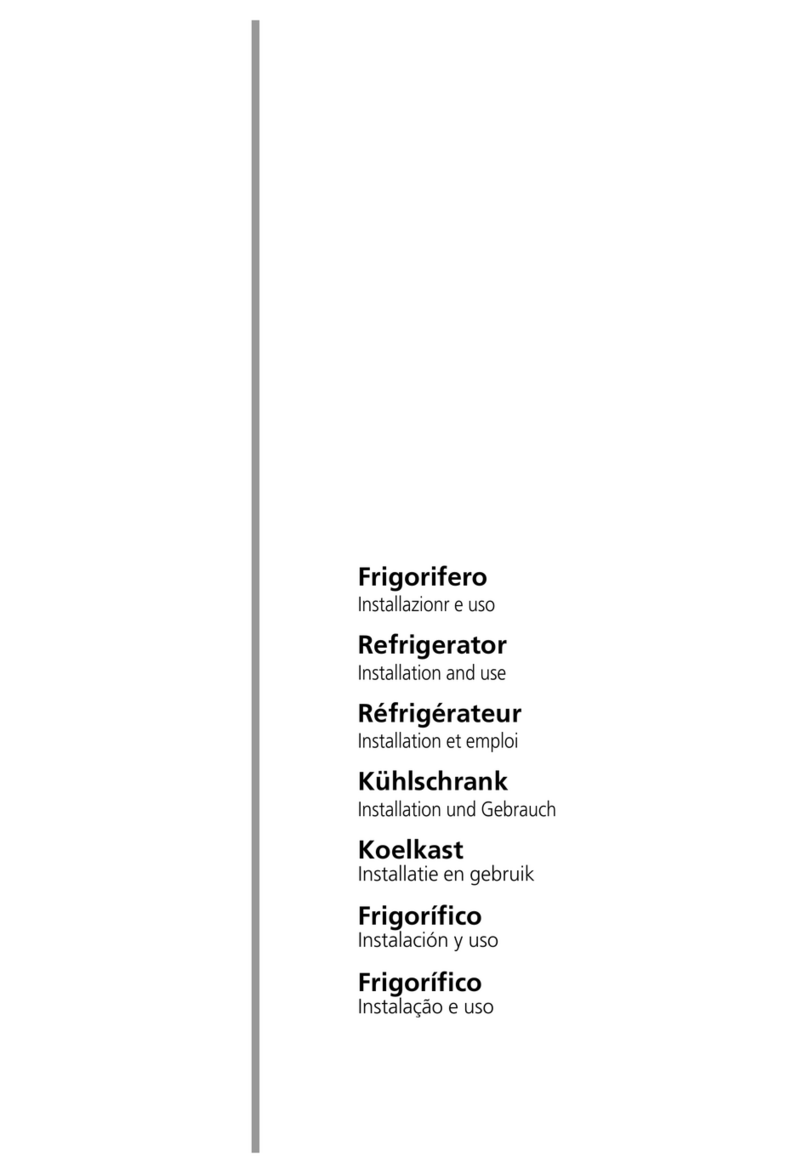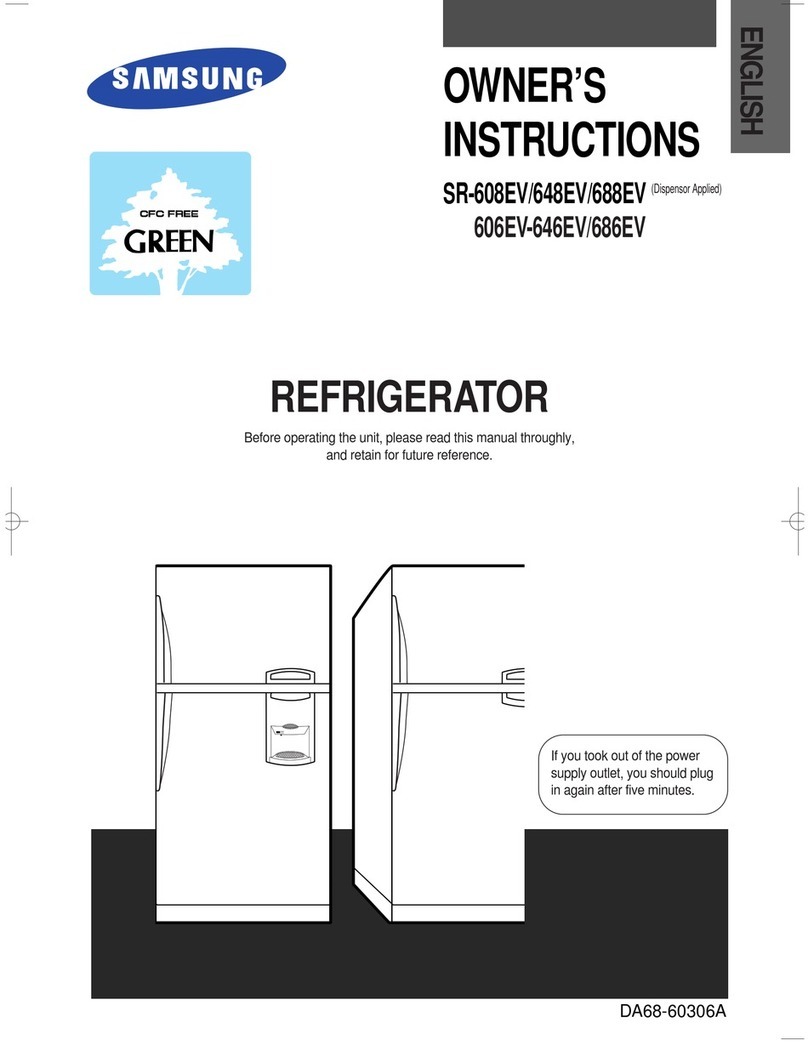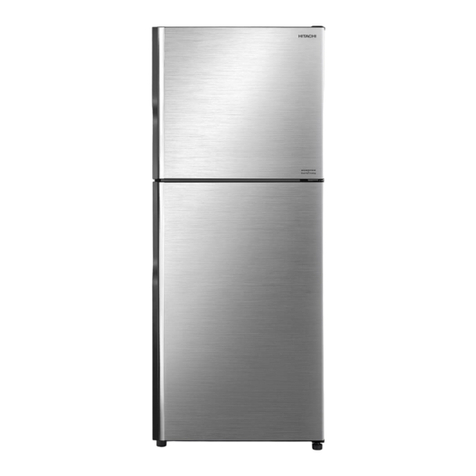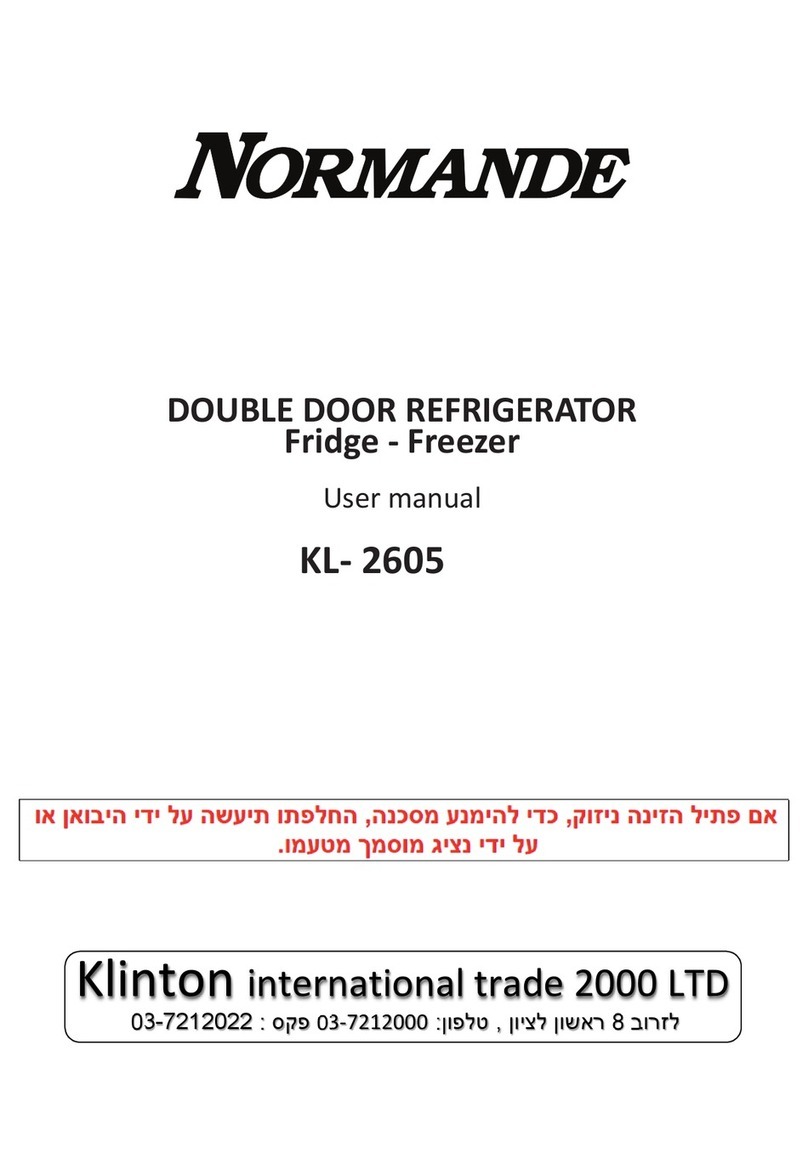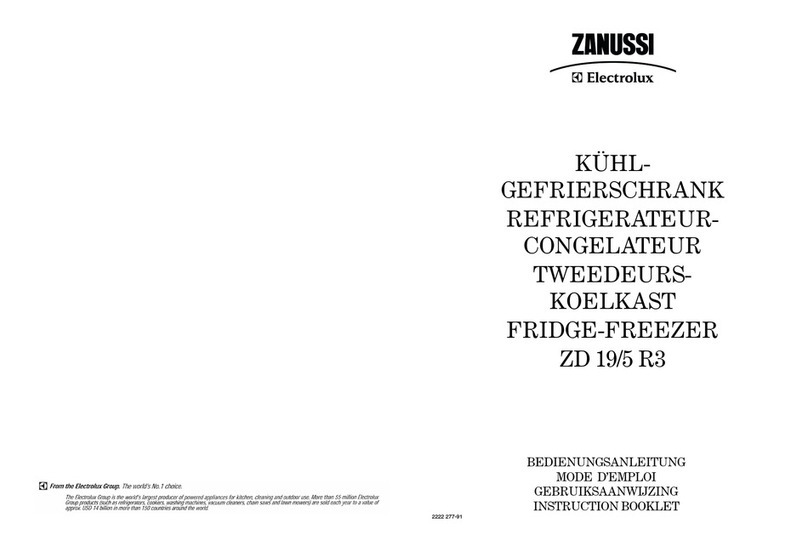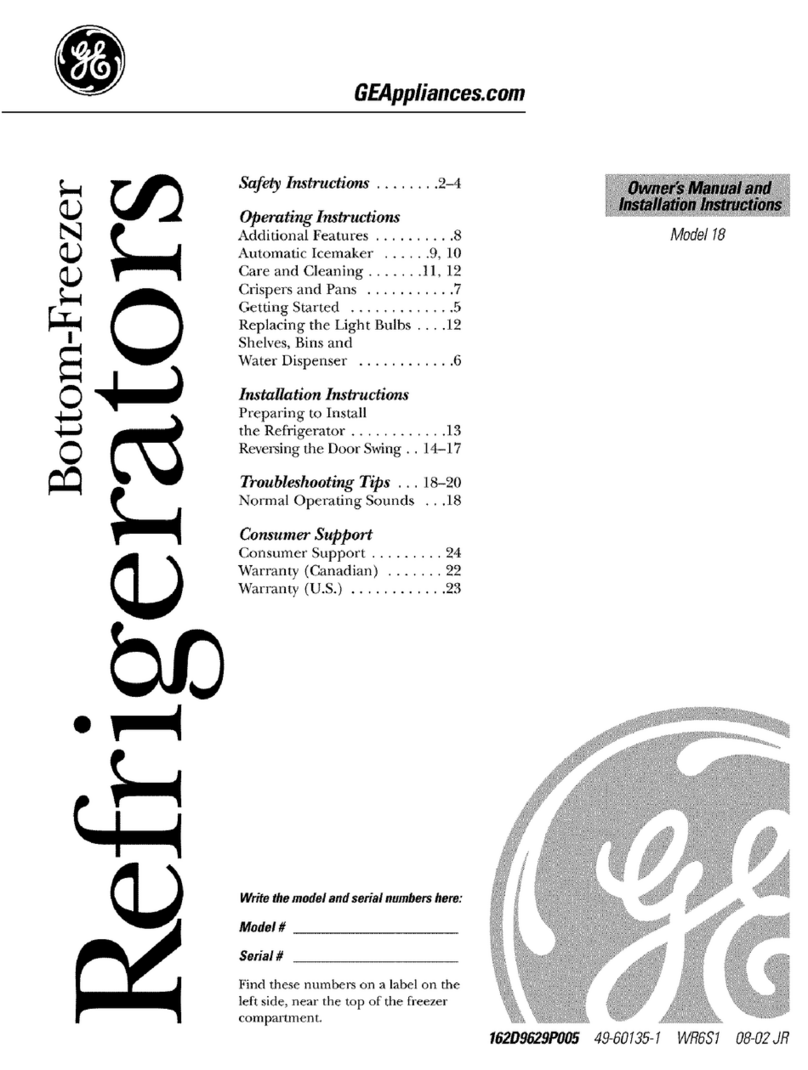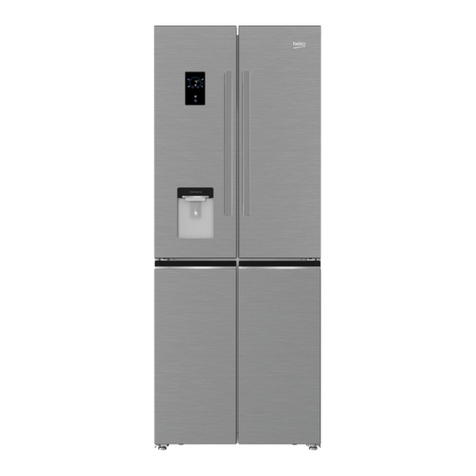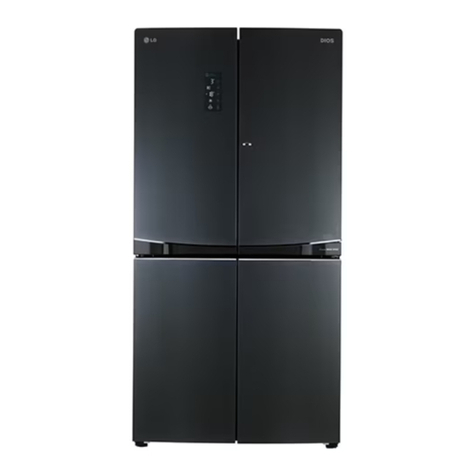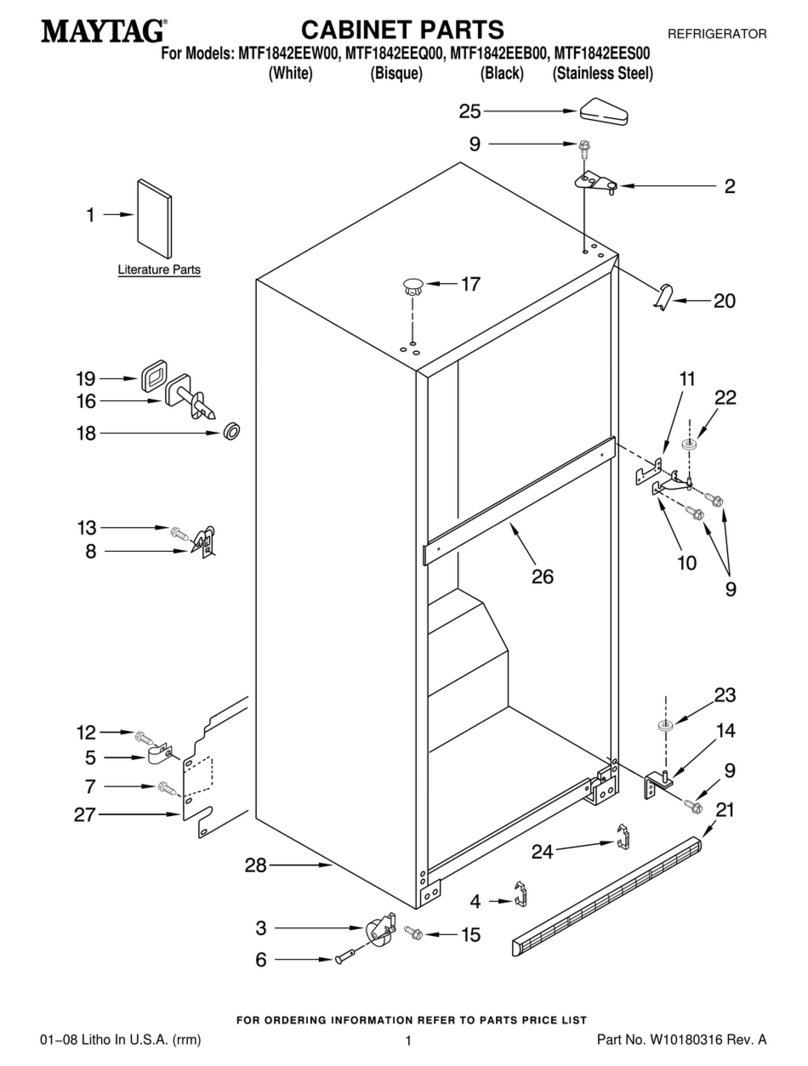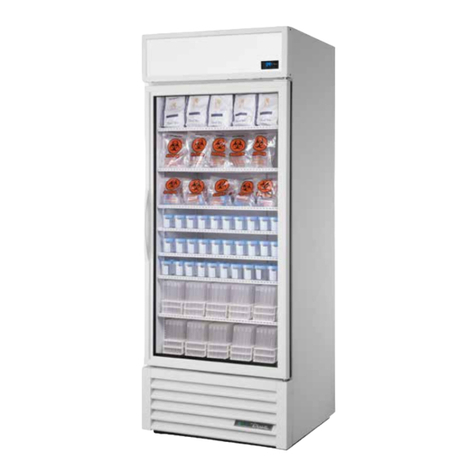LIMIT LIDDT217 User manual

LIDDT217

2
4
4
5
6
7
8
10
10
12

Do not store explosive substances such as
aerosol cans with a flammable propellant in
this appliance.
This appliance is intended to be used in
household and similar applications such as
-staff kitchen areas in shops, offices and
other working environments;
-farm houses and by clients in hotels,
motels and other residential type
environments;
-bed and breakfast type environments;
-catering and similar non-retail applications.
Keep burning candles,lamps and other
items with naked flames away from the
appliance so that do not set the appliance
on fire.
3

Control panel
Starting up and temperature regulation
The temperature selector knob is located
on the top of the refrigerator compartment.
Setting “0” means
Off.
to turn on the
appliance.
Setting “1” means
Highest temperature, warmest setting.
Setting “7” (end-stop) means
Lowest temperature, coldest setting.
Rotate the knob clockwise
Important! Normally, we advise you select a
setting of 2, or 3 or 4, if you want the
temperature higher or lower, please turn the
knob to a warmer or colder setting
accordingly. When you turn the knob to
this can lead to more energy
efficiency.
Important! High ambient temperatures (e.g.
on hot summer days) and a cold setting
(position 6 to 7) may cause the compressor
to run continuously or even nonstop!
Reason: when the ambient temperature is
high, the compressor must run continuously
to maintain a low temperature in the
appliance.
a
lower setting,
Otherwise, a higher setting will
lead in more energy consumption.
First use and installation
Cleaning before use
Before using the appliance for the first
time, wash the interior and all internal
accessories with lukewarm water and
some neutral soap so as to remove the
typical smell of a brand-new product, then
dry thoroughly.
Important! Do not use detergents or
abrasive powders, as these will damage the
finish.
Installation Positioning
Warning! Before installing, read the
instructions carefully for your safety
and the correct operation of the appliance.
Position the appliance away from sources
of heat such as stoves, radiators, direct
sunlight, etc.
Maximum performance and safety are
guaranteed by maintaining the correct
indoor temperature for the class of unit
concerned, as specified on the rating
plate.
ventilation, follow the instructions relevant
to the installation.
Wherever possible, the back of the
product should be against a wall to avoid
touching or catching warm parts
(compressor, condenser), and to prevent
the risk of fire, follow the instructions
relevant to installation.
The appliance must not be located close
to radiators or
Make sure that the main plug is accessible
after installation of the appliance.
cooking appliances.
Any electrical work required to do the
servicing of the appliance should be
carried out by qualified electrician or
person.
This product must be serviced by an
authorized Service Center, and only
genuine spare parts must be used.
authorized
Service
2) If the appliance contains a freezer compartment.
1) If the appliance is Frost Free.
4

This performs well from
. The appliance may not work properly
if it is left for a longer period at a
temperature above or below the indicated
range.
appliance N to
ST
Climate class Ambient temperature
SN
N
ST
T
+10°C to +32°C
+16°C to +32°C
+16°C to +38°C
+16°C to +43°C
Important!
For this
space should be
available around the . It is
advisable for there to be 75mm separating
the back of the to the wall, at
least 100mm of space on its two
of over 100mm from its top and a
clear space in front to allow the doors to
open 160°.
It is necessary to have good
ventilation around the refrigerator to allow
for the dissipation of heat, high efficiency,
and low power consumption.
reason, sufficiently cleared
refrigerator
appliance
sides, a
height
Sufficient air must be allowed to circulate
in the lower rear section of
as poor air circulation can affect perfor-
mance. Built-in appliances should be
positioned away from heat sources such
as heaters and direct sunlight.
the appliance,
Leveling
The appliance should be level in order to
eliminate vibration. To make the appliance
level, it should be upright and both adjusters
should be with the floor.
You can also adjust the level by
the appropriate level the front
(use your fingers or a suitable spanner).
in stable contact
unscrewing
adjustment in
Electrical connection
Caution! Any electrical work required to
install this appliance should be carried out
by a qualified or person.
Warning! This appliance must be
The declines any liability
should these safety measures not be
authorized
grounded.
manufacturer
observed.
Appliances must not be exposed to rain.
Daily use
Accessories 1)
Movable shelves/trays
Various glass,plastic storage shelves or
wire trays are included with your
appliance – different models have different
combinations and different models have
different
The walls of the refrigerator are equipped
with a series of runners so that the
shelves can be positioned as desired.
features.
Positioning the door shelves
To permit storage of food packages of
various sizes, the door shelves can be
placed at different heights.
To gradually pull the shelf in the
direction of the arrows until it comes free,
then as required.
adjust,
reposition
Vegetable Drawer
The drawer is suitable for storing fruit and
vegetables.
Ice-cube production
This appliance is equipped with one or
more trays for the production of ice cubes.
Freezing fresh food 2)
The freezer compartment is suitable for
freezing fresh food and storing frozen and
deep-frozen food for a long time.
The maximum amount of food that can be
frozen in 24 hours is specified on the
rating plate, a label located on the inside
of the appliance.
The freezing process lasts 24 hours:
during this period do not add any other
foods to be frozen.
Storing frozen food 2)
During first usage or after a period of no
use: Before putting the product in the
compartment, let the appliance run at
least 2 hours on the colder settings.
5

Important!
In order to make the most of the volume of
the fresh food storage compartment and
frozen-food storage compartment, the user
can remove one or more shelves or drawer
out of the appliance, according to your daily
use.
1) If the appliance contains related accessories
and functions.
2) If the appliance contains a freezer compartment.
Helpful hints and tips
Noises during operation
The following noises are characteristic of the
refrigeraty appliances:
Clicks- Whenever the compressor switches
on or off, a click can be heard.
Humming- As soon as the compressor is in
operation, you can hear it humming.
Bubbling- When refrigerant flows into thin
tubes, you can hear bubbling or splashing
noises.
Splashing- Even after the compressor has
been switched off, this noise can be heard
for a short time.
Energy saving tips
Do not install the appliance near cookers,
radiators or other sources of warmth.
Do not open the door too often or leave
the door open any longer than necessary.
Do not set the temperature colder than
necessary.
Make sure the side plates and back plate
of the appliance are at some distance
from the wall and follow the instructions
relevant to installation.
If shows the
combination for the drawers, crisper and
shelves, do not adjust the
would result in more
the diagram correct
combination as
it energy
consumption.
Hints for fresh food refrigeration
To obtain the best performance:
Do not store warm foods or evaporating
liquids in the appliance.
Do cover or wrap the food, particularly if it
Hints for freezing
The maximum quantity of food which can
be frozen in 24 hours is shown on the
rating plate.
The freezing process takes 24 hours.no
further food to be frozen should be added
during the period.
Only freeze top quality, fresh and
thoroughly cleaned foodstuffs.
Prepare food in small portions to enable it
to be rapidly and completely frozen and to
make it possible subsequently to thaw
only the quantity required
To help you make the most of the freezing
process there are some important hints:
Hints for refrigeration
Meat (all types): wrap in
bags and place on the glass shelf
above the vegetable drawer. For safety,
store in this way only one or two days at
the most.
Cooked foods, cold dishes, etc…: these
should be covered and may be placed on
any shelf.
Fruit and vegetables: these
should be thoroughly cleaned and placed
in the special drawer(s) provided.
Butter and cheese: these should be
placed in aluminum foil or
bags air as much as
possible.
Milk bottles: these should have a cap and
should be stored in the bottle rack on the
door.
polyethylene
(plastic)
Add bullet and move to the next
line down.
polyethylene
(plastic) removing
has a strong flavor.
Position food so that air can circulate
freely around it.
Thawing 2)
Deep-frozen or frozen food, prior to be
used, can be thawed in the freezer
compartment or at room temperature,
depending on the time available for this
operation.
Small pieces may even be cooked still
frozen, directly from the freezer. In this
case, cooking will take longer.
6

Wrap up the food in aluminum foil or
and make sure that
packages are airtight;
Do not allow fresh, unfrozen food to touch
food is already frozen, thus avoiding
a rise in temperature of the latter.
Lean foods store better and longer than
fatty ones; salt reduces the storage life of
food.
if consumed immediately after
removal from the freezer compartment, can
possibly cause skin to be freezer burnt.
polyethylene (plastic)
that
Iced products
It is recommended to label and date each
frozen package in order to keep track of the
storage time.
Hints for the storage of frozen food
Make sure that the commercially frozen
was stored by the retailer
Be sure that frozen food is transferred
from the store to the freezer in the
shortest possible time.
Do not open the door frequently or leave it
open longer than absolutely necessary.
Once defrosted, foods deteriorate rapidly
and can not be re-frozen.
Do not exceed the storage period
indicated by the food
Note: If the appliance contains related
accessories and functions.
grocery
manufacturer.
To obtain the best performance from this
appliance, you should:
Cleaning and care
Cleaning and care
For hygienic reasons, the appliance interior,
including interior accessories, should be
cleaned regularly.
The should be cleaned and
maintained at least every two months.
refrigerator
Warning! Danger of electrical shock!
The appliance should not be connected to
the during cleaning.
Before cleaning, switch the appliance off
and remove the plug from the
switch off, or the circuit
breaker or fuse.
main power supply
main power
supply, shut off
Important!
Remove the food from the appliance
before cleaning. Store them in a cool
place well covered.
Never clean the appliance with a steam
cleaner. Moisture could accumulate in
electrical components.
Hot vapor can lead to the damage of
plastic parts.
Ethereal oils and organic solvents can
attack plastic parts, e.g. lemon juice or the
juice from an orange peel, butyric acid,or
cleansers that contain acetic acid. Do not
allow such substances to come into
contact with appliance parts.
Do not use any abrasive cleansers.
and keep
water. Commercially available dish
washing detergents may also be used.
After cleaning, wipe with fresh water and a
clean dish cloth.
Accumulation of dust at the condenser
increases energy consumption; clean the
condenser at the back of the appliance
once a year with a soft brush or a
vacuum cleaner.
Check the water drain hole on the rear
wall of the refrigerator compartment.
Clear a blocked drain hole with the aid of
something like soft green peg,and be
careful not to any damage to the
cabinet by sharp
After everything is dry, the appliance
back into service.
create
objects.
can
be put
Defrosting
Why Change to "defrost your refrigerator?"
Water contained in food or air
inside the opening doors
may form a frost layer inside. will
weaken refrigeration when the frost is
thick. it more than 10mm
thick, you should defrost .
becoming
trapped due to
This
Once becomes
the appliance
Defrosting in fresh food storage
compartment
the
This is automatically controlled by
switching the temperature regulator On or
Off so that there is no need
defrosting . Water from defrosting
will be drained into a drip
tray through a drain pipe at the back of the
.
to use the
option
automatically
appliance
Clean the appliance and the interior
accessories with a cloth and lukewarm
7

What to do if…
Defrosting in storage
compartment
frozen food
Defrosting in the freezer chamber is
operated manually. Before defrosting, take
the food out.
Take the ice tray and drawers out or put
them into the fresh food compartment
temporarily.
Set the knob of the temperature regulator
to the “0”( where the compressor will stop
working) and leave the door of the
refrigerator open until ice and frost
dissolve thoroughly and at the
bottom of the freezer chamber. Wipe
the water with a soft cloth.
In up the process of
defrosting, you may put a bowl of warm
water (about 50°C) into the freezer
chamber, and scrape away the ice and
frost with a defrosting spatula. After doing
so, be sure to set the knob of the
temperature regulator to the original
position.
It is not advisable to heat the freezer
chamber directly with hot water or a hair
dryer while defrosting to avoid
deformation of the inner case.
It is also not advisable to scrape off ice
accumulate
out
order to speed
in order
Warning! off the appliance before
defrosting, turn the temperature regulator to
the “0” .
Important! The should be
defrosted at least month. During
, if the door opened
frequently or the appliance in
extreme humidity, we advise the user to
defrost every two weeks.
To switch
position
refrigerator
once a its
usage has been
has been used
No usage for extended periods of time
Remove all refrigerated packages.
Switch off the appliance by turning the
temperature regulator to the “0” .
Remove the main plug,switch off, or
disconnect the supply.
Clean thoroughly (see section: Cleaning
and Care)
Leave the door open to avoid the build up
of odors.
Note: the appliance contains a
freezer compartment.
position
electrical
Only if
Warning! Before trouble shooting,
disconnect the power supply. Only a
qualified electrician
person must carry out the
trouble shooting that is not in the
manual.
or other
authorized
Important! There are some sounds during
normal use(compressor, refrigerant
circulation)
Important!
Repairs to refrigerators/freezers may only
be performed by competent service
engineers. Improper repairs can give rise to
significant hazards for the user. If your
appliance needs repairing, please contact
your specialist dealer or your local
Center.Customer Service
and frost or separate foods from the containers
which have been congealed.Together with the
food with sharp tools or wooden bars, so as
not to damage the inner casing or the surface
of the evaporator.
Problem Possible cause Solution
Appliance does not
work.
Appliance cools too
much.
Appliance is not switched on.
Main plug is not plugged in or
is loose.
Fuse has blown or is defective.
Outlet is defective.
Temperature is set too cold.
Switch on the appliance.
Plug the appliance into the
electrical socket.
Check fuse, replace if necessary.
Defective parts need
repaired
to be
by an electrician.
Turn the temperature regulator to
a warmer setting temporarily.
8

The food is too warm.
Interior lighting does
not work.
Unusual noises.
The compressor does
not start immediately
after changing the
temperature setting.
Water on the floor or
storage shelves.
Temperature is not properly
adjusted.
Door was open for an
extended period.
A large quantity of warm food
was placed in the appliance
within the last 24 hours.
The appliance is near a heat
source.
Light bulb is defective.
Door seal is not air-tight
(possibly after reversing the
door).
Appliance is not level.
The appliance is touching the
wall or other objects.
A component, e.g. a pipe, on
the rear of the appliance is
touching another part of the
appliance or the wall.
This is normal, no error has
occurred.
Water drain hole is blocked.
Please the “Initial Start Up”
section.
refer to
Open the door only as long as
necessary.
Turn the temperature regulation
to a colder setting temporarily.
Please the “Installation
location” section.
refer to
Please look in the “changing the
Light Bulb “section.
Carefully warm the leaking
sections of the door seal with a
hair dryer (on a cool setting). At
the same time, shape the warmed
door seal by hand so that it sits
correctly.
Readjust the feet.
Move the appliance slightly.
If necessary, carefully bend the
component out of the way.
The compressor starts after a
period of time.
refer to the “Cleaning and care”
section.
Heavy build-up of
frost, possibly also on
the door seal.
Warning! If the light bulb is
damaged, THE USER MUST NOT
CHANGE IT!
Changing the light bulb by inexperienced
persons may cause injury or a serious
. It must be replaced by a
qualified persons in order to avoid a hazard.
Contact your local Service Force Center for
help.
malfunction
Before changing the light bulb, switch off
the appliance and unplug it, or pull the
fuse or the circuit breaker.
Light bulb data: 220-240 V,max.15W.
disconnect
To switch off the appliance, set the
temperature regulator to position “0”.
Unplug the mains plug
To change the light bulb, undo the screw.
Press the light bulb cover and slide it
backwards.
Change the defective light bulb.
Refit the light bulb cover and the screw.
Put the refrigerator back into operation.
Changing the light bulb
Bulb
Bulb cover
Screw Control Box
9

Description of the appliance
Reversing the door
1. Stand the refrigerator, use a flat bladed
screw driver to remove the 4 screw covers at
the rear of the refrigerator lid.
2. Unscrew and lift the lid from the rear
and remove it, then lift the upper door and
place it on a padded surface to prevent it
scratched.
View of the appliance
1. Ice tray
2. Shelf in freezer.
3. Temperature regulator
4. Storage shelves
5. Crisper cover
6. Crisper
7. Door shelf
8. Adjustable feet
1
2
3
4
5
6
7
8
The side in which the door opens can be
changed from the right side (as supplied) to
the left side, if the installation site
Tools you will need:
1. 8mm socket driver
2. Cross-shaped screwdriver
allows for it.
3. Putty knife or thin-blade screwdriver
Before you the on
it’s back in order to gain access to the base,
you should rest it on soft foam packaging or
similar material to avoid damaging the
cooling pipes at the rear of the .
begin, place refrigerator
refrigerator
10

3. Use a flat bladed screw driver to remove
the front ornament of top cover plate.
4.Replace the front ornament of top cover
plate in the other side.
5.Remove the upper hinge core, transfer it
to left side and tighten securely, then put it
in a safe place.
6. Remove both adjustable feet and remove
the bottom hinge bracket by unscrewing the
bolts.
8.Replace the lid by fitting the upper hinge
core into the upper door’s hole, securing it
with the 4 screws.Replace the screw covers.
Warning!
When changing the side at which the door
opens, the appliance must not be connected
to the mains. Remove plug from the mains
beforehand.
When you reverse the door,
Please do this first:
1. Move the accessory from the upper
cover of upper door ,tnen transfer the
accessory to the other side of the upper
cover.
2. Unscrew and remove both the screw
and the stopper from the upper door
and lower door ,then insert the screw and
the stopper to the other side hole of the
door,then tighten the screw.
7. Unscrew and remove the bottom hinge
pin, turn the bracket over and replace it.
Refit the bracket fitting the bottom hinge pin.
Replace both adjustable feet. Transfer the
lower door to the property position. Secure
the door's level, make the bottom hinge pin
into the lower hole of the door, then tight the
bolts.
4
3
1
2
3
1
2
34
1
11


LIDDT217

2
4
4
5
6
7
8
10
10
12

Interdit de storer les substances explosives
comme des contenants aérosols avec un
propulseur inflammable dans cet appareil.
Cet appareil est destiné à être utilisé dans les
maison et applications similaires comme
suivants :
-cuisine de staff dans les magasins, bureaux et
autres environnements de travail
-maisons de ferme et par les clients dans les
hôtels, motels et autres types d' environnements
résidentiels ;
-lit et les types d' environnements de petit
déjeuner ;
-nouriture et des applications de non-détaillants
similaires.
S'éloignez des bougies brûlants, lampes et
autres objets avec des flammes nues au
appareil afin de ne pas prvoquer en feu.
3

Panneau de commandes
Installation et première utilisation
Si vous réglez sur la valeur "7"
La température la plus basse (réglage au
plus froid).
Important!
l’appareil sur 2, 3 ou 4. Si vous souhaitez
que la température soit plus élevée ou plus
faible, réglez le bouton selon vos préférences.
Lorsque vous baissez l’intensité, votre système
consomme plus d’électricité. Dans le cas
contraire, vous économisez de l’énergie.
Important! Les températures ambiantes
élevées (ex: pendant les journées chaudes
d’été) associées à un réglage froid (6 ou
7), peuvent entraîner le fonctionnement en
continu du compresseur, parfois sans arrêt!
Raison: lorsque la température ambiante est
élevée, le compresseur fonctionne en continu
faible
Installation/Positionnement
Attention! Avant d’installer l’appareil,
lisez attentivement les consignes de
sécurité et d’utilisation du système.
Positionnez l’appareil à distance des
sources de chaleur telles que les fours,
radiateurs, rayons directs du soleil, etc.
Cet appareil fonctionnera dans les
meilleures conditions si vous respectez
la température intérieure conseillée sur la
plaque nominative.
Démarrage et régulation de la
température
Le régulateur de température est situé en
haut du compartiment réfrigérant.
Si vous réglez sur la valeur "0", cela
Arrêt
Tournez la molette dans le sens des aiguilles
d’une montre pour allumer l’appareil.
Si vous réglez sur la valeur "1", cela
La température la plus élevée (réglage au
plus chaud).
Nettoyage avant utilisation
Avant d’utiliser l’appareil pour la première
fois, nettoyez l’intérieur ainsi que tous les
accessoires intérieurs, au moyen d’eau tiède
des produits neufs, puis séchez entièrement.
Important! N’utilisez aucun détergent
ni aucune poudre abrasive car ceux-ci
Evitez autant que possible de coller à
une paroi murale l’arrière de l’appareil
ou des éléments chauds (compresseurs,
de
départ d’incendie. Suivez les consignes
d’installation.
Ne placez jamais l’appareil à proximité d’un
radiateur ou d’une cuisinière.
accessible après l’installation de l’appareil.
Dépannage
Toute opération électrique doit être
effectuée par une personne compétente ou
Ce produit ne doit être réparé que par une
ou conseillées par le fabricant doivent être
employées.
1)Si l’appareil ne renferme pas de givre.
2)Si l’appareil est doté d’un compartiment de
congélation.
4

ƔL’appareil ne fonctionnera plus correctement
s’il est laissé pendant une longue période
sur une température supérieure ou inférieure
à celle mentionnée.
Important! L’air doit pouvoir circuler
DXWRXUGXUpIULJpUDWHXUD¿QGHSHUPHWWUHOD
GLVVLSDWLRQGHODFKDOHXUO¶HI¿FDFLWpGHOD
réfrigération et la baisse de la consommation
électrique. A ce titre, vous devez veiller
jODLVVHUXQHVSDFHVXI¿VDQWDXWRXUGX
réfrigérateur. Nous conseillons de laisser 75
mm entre l’arrière du réfrigérateur et le mur,
au moins 100 mm des deux côtés et plus
de 100mm en hauteur. La porte doit pouvoir
s’ouvrir à 160°.
Type de climat Catégories de températures
SN +10°C à +32°C
N +16°C à +32°C
ST +16°C à +38°C
T +16°C à +43°C
GHO¶DSSDUHLOD¿QGHIDFLOLWHUODFLUFXODWLRQ
de l’air. Un manque de ventilation peut
détériorer le fonctionnement de l’appareil.
L’appareil doit être placé à distance des
sources de chaleur ou des rayons directs
du soleil.
Mise à niveau
ƔPour éliminer les vibrations, cet appareil
doit être àniveau. Pour cela, il doit être
installé bien droit et les deux pieds de mise
à niveau doivent être fermement en contact
avec le sol. Vous pouvez également le
mettre àniveau manuellement au moyen
d’une cale à l’avant ou à l’arrière (si le sol
est incliné).
Branchement électrique
Attention! Toutes les interventions
électriques nécessaires pour l’installation de
cet appareil doivent être effectuées par une
SHUVRQQHFRPSpWHQWHHWTXDOL¿pH
Attention! Cet appareil doit être relié au
sol. Le fabricant décline toute responsabilité
si ces mesures de sécurité ne sont pas
observées.
Utilisation quotidienne
Accessoires
Etagères/Plateaux amovibles
ƔPlusieurs étagères ou plateaux en
plastique sont fournis avec votre appareil.
Les différents modèles présentent des
propriétés différentes.
ƔLes parois du réfrigérateur sont dotées
de plusieurs rails destinées à recevoir les
étagères et les plateaux.
Positionnement des étagères
ƔPour faciliter le stockage des emballages
de différentes tailles, les étagères peuvent
être placées à différentes hauteurs.
ƔPour régler la hauteur des étagères,
tirez légèrement l’étagère dans le sens
LQGLTXpSDUODÀqFKHMXVTX¶jODOLEpUHUSXLV
repositionnez la selon vos préférences.
Compartiments à légumes
ƔCe compartiment est idéal pour ranger des
fruits et des légumes.
Fabrication de glaçons
ƔCet appareil est doté d’un ou de plusieurs
plateaux, permettant la fabrication de glaçons.
Congeler des aliments frais
ƔLe compartiment à congélation peut
permettre de congeler des aliments frais
ou recevoir des aliments déjà congelés et
ce pendant une longue période.
ƔLa quantité maximum d’aliments que vous
pouvez congeler en 24 heures est indiquée
sur la plaque nominative de l’appareil, elle-
même située à l’intérieur du réfrigérateur.
ƔLa congélation prend 24 heures. Pendant
cette période, ne mettez aucun autre
ingrédient à congeler.
Ranger des aliments déjà congelés
ƔConserver la première utilisation ou après
une longue période de non-utilisation. Avant
de placer le produit dans le compartiment,
laissez l’appareil tourner pendant au moins 2
heures au réglage le plus élevé.
Décongélation
ƔLes aliments congelés, avant d’être
utilisés, peuvent être décongelés
directement depuis le réfrigérateur ou à
température ambiante, en fonction du
temps dont vous disposez.
ƔNe jamais exposer l’appareil à la pluie. Un
HVSDFHVXI¿VDQWGRLWrWUHODLVVpjO¶DUULqUH
5

Astuces et conseils utiles
Bruits pendant le fonctionnement
Les bruits suivants sont caractéristiques des
appareils de réfrigération:
« Clics »: dès que le compresseur passe sur
Marche ou Arrêt, vous entendrez un « clic ».
Bourdonnements: lorsque le compresseur
est en fonctionnement, vous pouvez
entendre un bourdonnement.
«Gargouillis»: lorsque le liquide réfrigérant
circule dans les conduits, vous pouvez
entendre des gargouillis ou des bruits
similaires à des éclaboussures.
Eclaboussures: même après extinction du
compresseur, ce bruit peut continuer pendant
quelques minutes.
Conseils pour économiser l’énergie
ƔN’installez pas l'appareil à proximité de
cuisinières, de radiateurs ou d’autres
sources de chaleur.
ƔN’ouvrez pas la porte trop fréquemment et
ne la laissez pas ouverte plus longtemps
que nécessaire.
ƔNe réglez pas la température sur une
valeur plus froide que nécessaire.
ƔAssurez-vous que les plaques latérales
et la plaque arrière de l'appareil sont à
une certaine distance du mur, suivez les
instructions pertinentes à l'installation.
ƔSi le croquis ou la carte du réfrigérateur
montre la bonne combinaison des tiroirs,
bac à légumes et des étagères, ne réglez
pas la combinaison, il en résulterait une
consommation accentuée d'énergie.
Conseils pour la réfrigération des
aliments frais
Pour de meilleurs résultats:
ƔNe stockez pas d’aliments chauds ou de
liquides qui s’évaporent dans l’appareil.
ƔNe couvrez pas et n’emballez pas les
aliments, surtout s’ils dégagent une odeur
forte.
ƔPlacez les aliments de façon à laisser l’air
circuler autour.
ƔLes petits ingrédients peuvent être cuits
encore congelés, directement à la sortie
du congélateur. Dans ce cas, la caisson
est plus longue.
Important!
$¿QGHSRXYRLUVWRFNHUOHPD[LPXP
d’aliments frais dans le réfrigérateur et
le maximum d’aliments congelés dans le
congélateur, vous pouvez retirer une ou
plusieurs étagères et tiroirs en fonction de
l’utilisation que vous en faites.
1) Si l’appareil est doté des accessoires et des fonctions
citées.
2) Si le système est doté d’un compartiment à congélation.
Conseils pour la réfrigération
ƔViande (tous les types): enroulez les
morceaux de viande dans des sacs
polythène et disposez-les sur l’étagère en
verre située au-dessus du compartiment à
légumes. Pour votre sécurité, stockez un
ou deux jours au plus.
ƔAliments cuits, plats froids, etc…:
conservez-les sur n’importe quelle étagère.
Fruits et légumes : nettoyez-les bien et
rangez-les dans le compartiment réservé à
cet effet.
ƔBeurre et fromages: enroulez-les dans du
papier aluminium ou dans des sacs en
SRO\pWK\OqQHD¿QG¶H[FOXUHOHPD[LPXP
d’air possible.
ƔBouteilles de lait: elles doivent être
dotées d’un capuchon et rangées dans le
compartiment à bouteilles situé dans la
porte du réfrigérateur
Conseils pour la congélation
Pour vous aider à bien congeler vos
aliments, voici quelques conseils:
ƔLa quantité maximum d’éléments que vous
pouvez congeler en 24 heures est indiquée
sur la plaque nominative de l’appareil, elle-
même située à l’intérieur du réfrigérateur.
ƔLa congélation prend 24 heures. Pendant
cette période, ne mettez aucun autre
ingrédient à congeler.
ƔNe congelez que des aliments de grande
qualité, frais et des fruits bien nettoyés.
Ɣ3UpSDUH]GHSHWLWHVSRUWLRQVD¿QGH
faciliter la congélation et ainsi ne congeler
que la quantité nécessaire.
ƔProtégez les aliments dans du papier
aluminium ou dans des sacs en
polyéthylène et assurez-vous que les
emballages ne laissent pas passer l’air.
ƔNe laissez pas les aliments frais ou
décongeler entrer en contact avec des
produits congelés, car cela risquerait
d’entraîner une augmentation de la
température sur ces derniers.
6

ƔAssurez-vous que les aliments congelés
vendus dans le commerce étaient
correctement congelés par le vendeur.
ƔEssayez de réduire au maximum la durée
entre l’achat de produits congelés et leur
conservation dans votre congélateur.
ƔDo not open the door frequently or leave
it open longer than absolutely necessary.
Once defrosted, foods deteriorate rapidly
and can not be re-frozen.
ƔUne fois décongelés, les aliments
s’abiment vident et ne peuvent plus être
recongelés.
ƔNe dépassez pas la durée de congélation
indiquée sur l’emballage.
Remarque: si l’appareil est doté des
accessoires et des fonctions citées.
ƔLes ingrédients maigres se conservent
mieux et plus longtemps que les
ingrédients gras; le sel réduit la durée de
congélation des aliments.
ƔLes glaces à l’eau, si elles sont
consommées juste à leur sortie du
congélateur, peuvent brûler.
ƔNous vous conseillons de surveiller la date
de péremption indiquée sur les produits
FRQJHOpVD¿QG¶pYLWHUODFRQVRPPDWLRQ
d’ingrédients périmés.
Astuce de conservation pour
aliments déjà congelés
Pour obtenir les meilleurs résultats possibles
de cet appareil:
Nettoyage et entretien
Nettoyage et entretien
Pour des raisons d’hygiène, les composants
intérieurs de l’appareil, y compris les
accessoires, doivent être nettoyés
régulièrement.
Le réfrigérateur doit être nettoyé et entretenu
au moins tous les deux mois.
Attention! Risque d’électrocution!
ƔPendant les phases de nettoyage,
l’appareil doit être débranché. Avant de
nettoyer l’appareil, coupez l’alimentation
électrique, ou arrêtez le disjoncteur.
Important!
ƔAvant de procéder au nettoyage, retirez
les aliments du réfrigérateur. Rangez les
aliments dans un endroit frais, à l’abri.
ƔNe nettoyez jamais l’appareil au moyen
d’un vaporetto. De la moisissure peut
s’accumuler dans les composants
électriques.
ƔLes vapeurs chaudes peuvent conduire à
une détérioration des éléments en plastique.
ƔLes huiles qui s’évaporent et les solvants
peuvent attaquer les éléments en
plastique, par exemple le jus de citron
ou le jus des écorces d’orange, l’acide
butyrique, ou tout autre agent nettoyant
contenant de l’acide acétique. Ne laissez
aucune de ces substances entrer en
contact avec les éléments de l’appareil.
ƔN’utilisez pas d’agents abrasifs.
ƔNettoyez l’appareil et ses accessoires
intérieurs avec chiffon doux et de l’eau tiède.
Vous pouvez aussi recourir aux produits
VSpFL¿TXHVYHQGXVGDQVOHFRPPHUFH
ƔAprès avoir nettoyé l’appareil, rincez-le au
moyen d’un chiffon imbibé d’eau chaude.
ƔL’accumulation de poussière au niveau du
condensateur augmente la consommation
d’énergie. Nettoyez le condensateur à
l’arrière de l’appareil une fois par an, au
moyen d’une brosse à poils souples ou
d’un aspirateur.
Ɣ9pUL¿H]OHFRQGXLWG¶pYDFXDWLRQjO¶DUULqUH
du compartiment de réfrigération.
ƔSi le conduit est bouché, débouchez-le au
PR\HQSDUH[HPSOHG¶XQDJHQWVSpFL¿TXH
Faites attention à ne pas endommager le
boîtier avec des objets pointus.
ƔUne fois le conduit débouché, vous pouvez
remettre l’appareil en fonctionnement.
Dégivrage Pourquoi dégivrer?
ƔL’eau qui est contenu dans les aliments
et qui se causent par l’ouverture de la
portière, se répand dans l’air à l’intérieur
du réfrigérateur. Ceci a pour implication
de réduire la réfrigération lorsque le givre
devient épais. Si le givre atteint les 10mm
d’épaisseur, il faut absolument dégivrer.
Le dégivrage des compartiments de
rangement des aliments frais
ƔL’eau contenue dans les aliments ou dans
l’air en suspension dans le réfrigérateur peut
se transformer en une couche de givre. Ceci
UHQGODUpIULJpUDWLRQSOXVGLI¿FLOH/RUVTXH
cette couche fait plus de 10mm d’épaisseur,
vous devez dégivrer votre appareil.
7

Cleaning and Care
Attention! Avant de tenter
de réparer l’appareil, coupez
l’alimentation électrique. Seul un technicien
TXDOL¿pRXXQHSHUVRQQHFRPSpWHQWHSHXW
se charger de résoudre les problèmes autres
ceux mentionnés dans le manuel.
Important! Même lors de son
fonctionnement normal, l’appareil émet des
sons (compresseur, circuit réfrigérant)
Problème possible Cause possible Solution
L’appareil ne
fonctionne pas.
L’appareil n’est pas allumé. Allumez l’appareil.
La prise principales n’est pas
branchée ou est lâche. Insérez la prise principale.
Le fusible a grillé ou est
défectueux
Contrôlez le fusible, remplacez-le
si nécessaire.
La prise est défectueuse. Les prises défectueuses doivent
être reparées par un électricien.
L’appareil réfrigère
trop.
/DWHPSpUDWXUHHVWFRQ¿JXUpH
sur une valeur trop faible.
Placez le régulateur de température
sur une valeur plus chaude.
ƔNous ne vous recommandons pas non
plus de gratter la glace avec des objets
pointus ou des pics en bois, car cela
risquerait d’endommager la surface de
l’évaporateur.
Attention! Eteignez l’appareil avant de le
dégivrer, placez le régulateur de temperature
sur la position “0”.
Important! Le réfrigérateur doit être dégivré
au moins tous les mois. Si la porte est
fréquemment ouverte ou si l’appareil est
exposé à une forte humidité, nous vous
conseillons de le dégivrer toutes les deux
semaines.
En cas d’absence prolongée
ƔRetirez tous les emballages du réfrigérateur.
ƔEteignez l’appareil en plaçant le régulateur
de température sur la position “0”.
ƔRetirez le cordon d’alimentation ou coupez
l’alimentation électrique.
ƔNettoyez bien l’appareil (consultez la
rubrique: Nettoyage et entretien)
Ɣ/DLVVH]ODSRUWHRXYHUWHD¿QG¶pYLWHUOD
formation d’odeurs désagréables.
Remarque: si l’appareil est doté d’un
compartiment à congélation
Important!
Les réparations apportées au congélateur/
réfrigérateur ne doivent être effectuées
que par des personnes compétentes ou
GHVWHFKQLFLHQVTXDOL¿pV8QHPDXYDLVH
réparation peut représenter un danger grave
pour l’utilisateur. Si votre appareil doit être
réparé, contactez votre revendeur ou un
centre technique agréé.
Que faire si…
Dégivrer le compartiment à
réfrigération
ƔPour dégivrer le compartiment à
congélation, vous devez procéder
manuellement. Avant le dégivrage, retirez
tous les aliments.
ƔRetirez les plateaux et les tiroirs pour les
placer dans le réfrigérateur le temps du
dégivrage.
ƔPlacez le régulateur de température sur
la position “0”(le compresseur arrête de
fonctionner) et laissez la porte ouverte
jusqu’à ce que la glace et le givre fondent
et s’accumulent dans le congélateur.
Epongez l’eau avec un chiffon absorbant.
ƔPour accélérer le processus de
décongélation, vous pouvez placer un
bol d’eau chaude (environ 50°C) dans
le compartiment à congélation et grattez
la glace avec une raclette. Après cela,
placez le régulateur de température sur sa
position d’origine.
ƔNous vous déconseillons de chauffer le
compartiment à congélation directement
avec de l’eau chaude ou un sèche-
FKHYHX[SHQGDQWOHGpJLYUDJHD¿QG¶pYLWHU
la déformation de la paroi intérieure.
8
Table of contents
Languages:
Other LIMIT Refrigerator manuals

